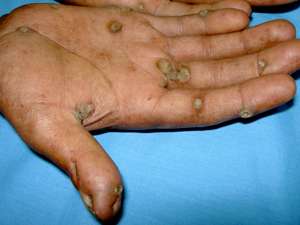A family found to have a self-healing skin cancer offers hope for better treatments

Members of a Tunisian family with tumors on their hands, feet and eyes may provide helpful information for the treatment of squamous cell carcinoma, a common skin cancer.
The family was brought to the attention of Bruno Reversade and his team at the A*STAR Institute of Medical Biology, who specialize in identifying the causal genes in human familial disorders.
"We focus on human genetics—if we see a trait or disease that is inherited, we will put all our effort into finding the causative gene," says Reversade.
Many members of the family, spanning five generations, have the disease, which manifests as multiple tumors known as keratoacanthomas. These tumors occur on hairless areas of the body such as the palms (see image), the soles of the feet and the conjunctiva of the eye.
After about six months, the tumors spontaneously start to heal, eventually just leaving a scar. Unfortunately, the tumors may metastasize to other places in the body, where no self-healing occurs, which means the disease can be fatal.
What is interesting about this family, however, is that the disease is clearly being caused by a mutation in a single gene, explains Reversade.
Work done by Reversade's team shows that the gene in question lies on a region of chromosome 17 and that the mutation is dominant, hence always expressed if a person carries it.
"We have actually found two other families with this same disease—one from Romania and one from France. We now know that all three families carry a common mutated gene," he says.
The A*STAR team is now working on finding out how this gene controls skin cell differentiation. Reversade believes it may prove to be a gene involved in the innate immune system and that this may explain why the cancers heal.
"I suspect the gene may have a dual function: it could have a pro-cancerous effect in skin cells whereas it could have an anti-proliferative effect in the immune system." Alternatively, he says the gene may initiate cancers by lowering immunity, but then its effect on the skin cells may cause regression of the tumors.
"Either way, it should give us an insight into how the immune system can be harnessed to fight cancer," he says.
More information: "Multiple self-healing palmoplantar carcinoma: A familial predisposition to skin cancer with primary palmoplantar and conjunctival lesions." Journal of Investigative Dermatology 135, 304–308 (2015). dx.doi.org/10.1038/jid.2014.311















